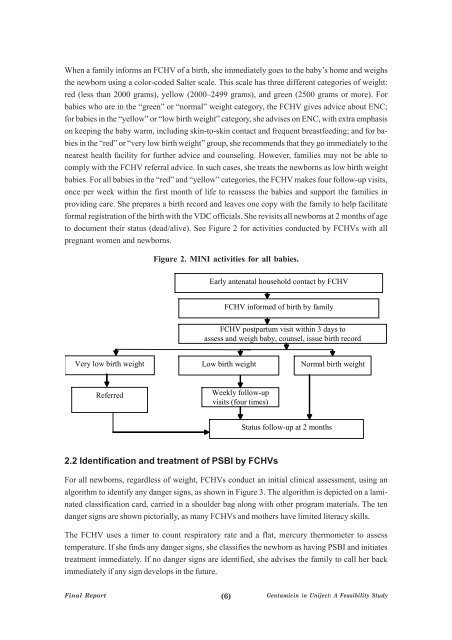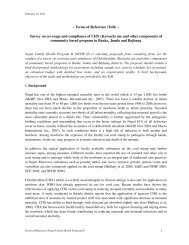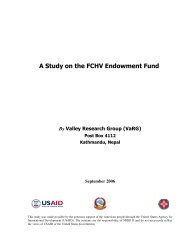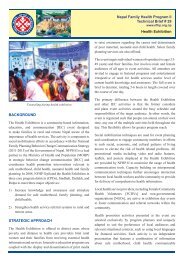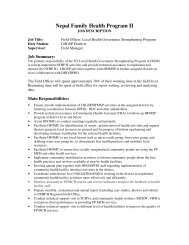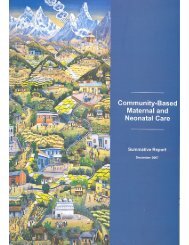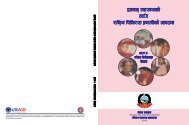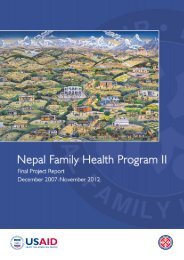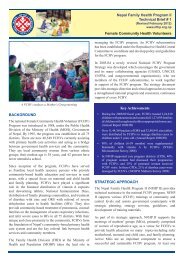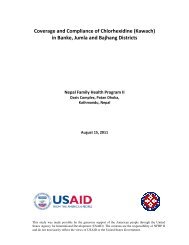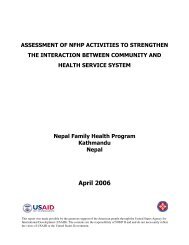Design-Stage Trial of Gentamicin in the Uniject Device
Design-Stage Trial of Gentamicin in the Uniject Device
Design-Stage Trial of Gentamicin in the Uniject Device
Create successful ePaper yourself
Turn your PDF publications into a flip-book with our unique Google optimized e-Paper software.
When a family <strong>in</strong>forms an FCHV <strong>of</strong> a birth, she immediately goes to <strong>the</strong> baby’s home and weighs<strong>the</strong> newborn us<strong>in</strong>g a color-coded Salter scale. This scale has three different categories <strong>of</strong> weight:red (less than 2000 grams), yellow (2000–2499 grams), and green (2500 grams or more). Forbabies who are <strong>in</strong> <strong>the</strong> “green” or “normal” weight category, <strong>the</strong> FCHV gives advice about ENC;for babies <strong>in</strong> <strong>the</strong> “yellow” or “low birth weight” category, she advises on ENC, with extra emphasison keep<strong>in</strong>g <strong>the</strong> baby warm, <strong>in</strong>clud<strong>in</strong>g sk<strong>in</strong>-to-sk<strong>in</strong> contact and frequent breastfeed<strong>in</strong>g; and for babies<strong>in</strong> <strong>the</strong> “red” or “very low birth weight” group, she recommends that <strong>the</strong>y go immediately to <strong>the</strong>nearest health facility for fur<strong>the</strong>r advice and counsel<strong>in</strong>g. However, families may not be able tocomply with <strong>the</strong> FCHV referral advice. In such cases, she treats <strong>the</strong> newborns as low birth weightbabies. For all babies <strong>in</strong> <strong>the</strong> “red” and “yellow” categories, <strong>the</strong> FCHV makes four follow-up visits,once per week with<strong>in</strong> <strong>the</strong> first month <strong>of</strong> life to reassess <strong>the</strong> babies and support <strong>the</strong> families <strong>in</strong>provid<strong>in</strong>g care. She prepares a birth record and leaves one copy with <strong>the</strong> family to help facilitateformal registration <strong>of</strong> <strong>the</strong> birth with <strong>the</strong> VDC <strong>of</strong>ficials. She revisits all newborns at 2 months <strong>of</strong> ageto document <strong>the</strong>ir status (dead/alive). See Figure 2 for activities conducted by FCHVs with allpregnant women and newborns.Figure 2. MINI activities for all babies.Early antenatal household contact by FCHVFCHV <strong>in</strong>formed <strong>of</strong> birth by familyFCHV postpartum visit with<strong>in</strong> 3 days toassess and weigh baby, counsel, issue birth recordVery low birth weightLow birth weightNormal birth weightReferredWeekly follow-upvisits (four times)Status follow-up at 2 months2.2 Identification and treatment <strong>of</strong> PSBI by FCHVsFor all newborns, regardless <strong>of</strong> weight, FCHVs conduct an <strong>in</strong>itial cl<strong>in</strong>ical assessment, us<strong>in</strong>g analgorithm to identify any danger signs, as shown <strong>in</strong> Figure 3. The algorithm is depicted on a lam<strong>in</strong>atedclassification card, carried <strong>in</strong> a shoulder bag along with o<strong>the</strong>r program materials. The tendanger signs are shown pictorially, as many FCHVs and mo<strong>the</strong>rs have limited literacy skills.The FCHV uses a timer to count respiratory rate and a flat, mercury <strong>the</strong>rmometer to assesstemperature. If she f<strong>in</strong>ds any danger signs, she classifies <strong>the</strong> newborn as hav<strong>in</strong>g PSBI and <strong>in</strong>itiatestreatment immediately. If no danger signs are identified, she advises <strong>the</strong> family to call her backimmediately if any sign develops <strong>in</strong> <strong>the</strong> future.F<strong>in</strong>al Report(6) <strong>Gentamic<strong>in</strong></strong> <strong>in</strong> <strong>Uniject</strong>: A Feasibility Study


